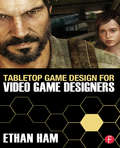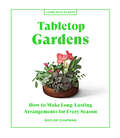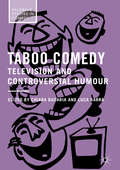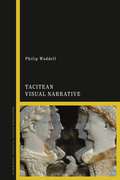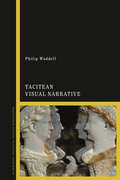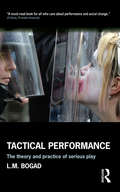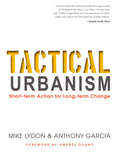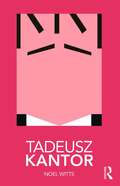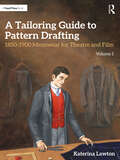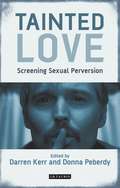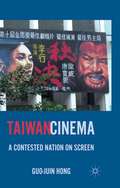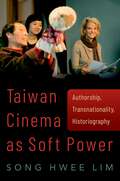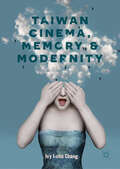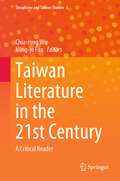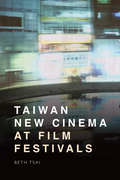- Table View
- List View
Tabletop Game Design for Video Game Designers
by Ethan HamLearn the mechanics that take your game from an idea to a playable product. Do you aspire to be a game designer but aren’t sure where to begin? Tabletop Game Design for Video Game Designers guides you through your initial attempts to design game mechanics. It goes beyond simple description and definition to explore in detail the issues that designers grapple with for every game they create. Learning to design tabletop games builds a solid foundation for game designers and provides methods that can be applied towards creating paper prototypes of computer-targeted games. Presented in a step-by-step format, Tabletop Game Design for Video Game Designers helps the reader understand how the game design skills that are acquired through creating tabletop games can be used when designing video games. Fully playable games accompany every topic so you can truly understand and experience each component that goes into game creation. Tabletop Game Design for Video Game Designers includes: Simple, highly focused games that can be played, analyzed, improved, and/or modified in conjunction with a particular topic in the book. Integrated game design exercises, chapter learning objectives, and in-text sidebars to provide further examples to apply directly to your game creation process. A companion website (www.funmines.com) which includes: "print & play" tabletop games, links to online games, game design resources, and articles about designing and developing games.
Tabletop Game Design for Video Game Designers
by Ethan HamLearn the mechanics that take your game from an idea to a playable product. Do you aspire to be a game designer but aren’t sure where to begin? Tabletop Game Design for Video Game Designers guides you through your initial attempts to design game mechanics. It goes beyond simple description and definition to explore in detail the issues that designers grapple with for every game they create. Learning to design tabletop games builds a solid foundation for game designers and provides methods that can be applied towards creating paper prototypes of computer-targeted games. Presented in a step-by-step format, Tabletop Game Design for Video Game Designers helps the reader understand how the game design skills that are acquired through creating tabletop games can be used when designing video games. Fully playable games accompany every topic so you can truly understand and experience each component that goes into game creation. Tabletop Game Design for Video Game Designers includes: Simple, highly focused games that can be played, analyzed, improved, and/or modified in conjunction with a particular topic in the book. Integrated game design exercises, chapter learning objectives, and in-text sidebars to provide further examples to apply directly to your game creation process. A companion website (www.funmines.com) which includes: "print & play" tabletop games, links to online games, game design resources, and articles about designing and developing games.
Tabletop Gardens: How to Make Long-Lasting Arrangements for Every Season (Living with Plants)
by Baylor ChapmanBlooming houseplants flourish in the spotlight in this unique book on projects for flowering plant displays, adapted from The Plant Recipe Book by Baylor Chapman.
Taboo Comedy: Television and Controversial Humour (Palgrave Studies in Comedy)
by Chiara Bucaria Luca BarraThe essays in this collection explore taboo and controversial humour in traditional scripted (sitcoms and other comedy series, animated series) and non-scripted forms (stand-up comedy, factual and reality shows, and advertising) both on cable and network television. Whilst the focus is predominantly on the US and UK, the contributors also address more general and global issues and different contexts of reception, in an attempt to look at this kind of comedy from different perspectives. Over the last few decades, taboo comedy has become a staple of television programming, thus raising issues concerning its functions and appropriateness, and making it an extremely relevant subject for those interested in how both humour and television work.
Tacitean Visual Narrative
by Philip WaddellCombining the studies of modern film, traditional narratology, and Roman art, this interdisciplinary work explores the complex and highly visual techniques of Tacitus' Annales. The volume opens with a discussion of current research in narratology, as applied to Roman historians. Narratology is a helpful and insightful tool, but is often inadequate to deal with specifically visual aspects of ancient narrative. In order to illuminate Tacitus' techniques, and to make them speak to modern readers, this book focuses on drawing and illustrating parallels between Tacitus' historiographical methods and modern film effects. Building on these premises, Waddell examines a wide array of Tacitus' visual narrative devices. Tacitean examples are discussed in light of their narrative effect and purpose in the Annales, as well as the ways in which they are similar to contemporary Roman art and modern film techniques, including focalization, alignment, use of the ambiguous gaze, temporal suggestion and quick-cutting. Through this approach the modern scholar gains a deeper understanding of the many ways in which Tacitus' Annales act upon the reader, and how his narrative technique helps to shape, guide, and deeply layer his history.
Tacitean Visual Narrative
by Philip WaddellCombining the studies of modern film, traditional narratology, and Roman art, this interdisciplinary work explores the complex and highly visual techniques of Tacitus' Annales. The volume opens with a discussion of current research in narratology, as applied to Roman historians. Narratology is a helpful and insightful tool, but is often inadequate to deal with specifically visual aspects of ancient narrative. In order to illuminate Tacitus' techniques, and to make them speak to modern readers, this book focuses on drawing and illustrating parallels between Tacitus' historiographical methods and modern film effects. Building on these premises, Waddell examines a wide array of Tacitus' visual narrative devices. Tacitean examples are discussed in light of their narrative effect and purpose in the Annales, as well as the ways in which they are similar to contemporary Roman art and modern film techniques, including focalization, alignment, use of the ambiguous gaze, temporal suggestion and quick-cutting. Through this approach the modern scholar gains a deeper understanding of the many ways in which Tacitus' Annales act upon the reader, and how his narrative technique helps to shape, guide, and deeply layer his history.
Tactical Performance: Serious Play and Social Movements
by Larry BogadTactical Performance tells fun, mischievous stories of underdogs speaking mirth to power - through creative, targeted activist performance in the streets of cities around the world. This compelling, inspiring book also provides the first ever full-length practical and theoretical guide to this work. L.M.Bogad, one of the most prolific practitioners and scholars of this genre, shares the most effective non-violent tactics and theatrics employed by groups which have captured the public imagination in recent years. Tactical Performance explores carnivalesque protest in unique depth, looking at the possibilities for direct action and sometimes shocking confrontation with some of the most powerful institutions in the world. It is essential reading for anyone interested in creative pranksterism and the global justice movement.
Tactical Performance: Serious Play and Social Movements
by Larry BogadTactical Performance tells fun, mischievous stories of underdogs speaking mirth to power - through creative, targeted activist performance in the streets of cities around the world. This compelling, inspiring book also provides the first ever full-length practical and theoretical guide to this work. L.M.Bogad, one of the most prolific practitioners and scholars of this genre, shares the most effective non-violent tactics and theatrics employed by groups which have captured the public imagination in recent years. Tactical Performance explores carnivalesque protest in unique depth, looking at the possibilities for direct action and sometimes shocking confrontation with some of the most powerful institutions in the world. It is essential reading for anyone interested in creative pranksterism and the global justice movement.
Tactical Urbanism: Short-term Action For Long-term Change
by Mike Lydon Anthony GarciaShort-term, community-based projects—from pop-up parks to open streets initiatives—have become a powerful and adaptable new tool of urban activists, planners, and policy-makers seeking to drive lasting improvements in their cities and beyond. These quick, often low-cost, and creative projects are the essence of the Tactical Urbanism movement. Whether creating vibrant plazas seemingly overnight or re-imagining parking spaces as neighborhood gathering places, they offer a way to gain public and government support for investing in permanent projects, inspiring residents and civic leaders to experience and shape urban spaces in a new way.Tactical Urbanism, written by Mike Lydon and Anthony Garcia, two founders of the movement, promises to be the foundational guide for urban transformation. The authors begin with an in-depth history of the Tactical Urbanism movement and its place among other social, political, and urban planning trends, and a detailed set of case studies demonstrate the breadth and scalability of tactical urbanism interventions. Finally, the book provides a detailed toolkit for conceiving, planning, and carrying out projects, including how to adapt them based on local needs and challenges.Tactical Urbanism will inspire and empower a new generation of engaged citizens, urban designers, land use planners, architects, and policymakers to become key actors in the transformation of their communities.
Tadeusz Kantor (Routledge Performance Practitioners)
by Noel WittsTadeusz Kantor – a theoretician, director, innovator and painter famed for his very visual theatre style – was a key figure in European avant-garde theatre. He was also known for his challenging theatrical innovations, such as extending stages and the combination of mannequins with living actors. The book combines: a detailed study of the historical context of Kantor’s work an exploration of Kantor’s own writings on his theatrical craft a stylistic analysis of the key works, including The Dead Class and Let the Artists Die, and their critical reception an examination of the practical exercises devised by Kantor. As a first step towards critical understanding, and as an initial exploration before going on to further, primary research, Routledge Performance Practitioners offer unbeatable value for today’s student.
Tadeusz Kantor (Routledge Performance Practitioners)
by Noel WittsTadeusz Kantor – a theoretician, director, innovator and painter famed for his very visual theatre style – was a key figure in European avant-garde theatre. He was also known for his challenging theatrical innovations, such as extending stages and the combination of mannequins with living actors. The book combines: a detailed study of the historical context of Kantor’s work an exploration of Kantor’s own writings on his theatrical craft a stylistic analysis of the key works, including The Dead Class and Let the Artists Die, and their critical reception an examination of the practical exercises devised by Kantor. As a first step towards critical understanding, and as an initial exploration before going on to further, primary research, Routledge Performance Practitioners offer unbeatable value for today’s student.
A Tailoring Guide to Pattern Drafting: 1850-1900 Menswear for Theatre and Film, Volume 1
by Katerina LawtonA Tailoring Guide to Pattern Drafting offers pattern drafting instructions for men’s most popular tailored garment styles from 1850 to 1900, used in theatres and film productions today. The book features a wide range of 19th-century garments, providing information and detailed instructions on the frock coat, morning coat, lounge jacket, smoking jacket, shirt, waistcoats, trousers and long-riding breeches. It includes a brief history of each garment, accompanied by colourful illustrations and easy-to-follow instruction to draft historical 19th-century silhouettes for modern performances. The book features: A brief history of each garment, accompanied by full-colour illustrations. Modern step-by-step instructions with clear diagrams to draft 19th-century menswear. Instructions incorporating both the imperial and metric systems. Recommendations on choosing the appropriate modern-day equivalent fabric. Recommendations on the quantity of the fabric. Recommendations on the button size to make the garment appear more authentic. A table of Dress Code Ethics for Gentlemen from 1850 to 1900. Descriptions and visual information on how to take accurate measurements. Photographs of costumes and images of the 19th-century Carte de Visite for visual support. A Tailoring Guide to Pattern Drafting is intended for anyone with a desire to learn or refine their costume-cutting skills for theatre and film production. The book is aimed at undergraduate and graduate students, tutors and both amateur and professional makers interested in the subject. To access the author’s YouTube channel, featuring 130 step-by-step lessons to make a 19th-century Morning Coat using classical tailoring techniques, visit www.routledge.com/9780367265335.
A Tailoring Guide to Pattern Drafting: 1850-1900 Menswear for Theatre and Film, Volume 1
by Katerina LawtonA Tailoring Guide to Pattern Drafting offers pattern drafting instructions for men’s most popular tailored garment styles from 1850 to 1900, used in theatres and film productions today. The book features a wide range of 19th-century garments, providing information and detailed instructions on the frock coat, morning coat, lounge jacket, smoking jacket, shirt, waistcoats, trousers and long-riding breeches. It includes a brief history of each garment, accompanied by colourful illustrations and easy-to-follow instruction to draft historical 19th-century silhouettes for modern performances. The book features: A brief history of each garment, accompanied by full-colour illustrations. Modern step-by-step instructions with clear diagrams to draft 19th-century menswear. Instructions incorporating both the imperial and metric systems. Recommendations on choosing the appropriate modern-day equivalent fabric. Recommendations on the quantity of the fabric. Recommendations on the button size to make the garment appear more authentic. A table of Dress Code Ethics for Gentlemen from 1850 to 1900. Descriptions and visual information on how to take accurate measurements. Photographs of costumes and images of the 19th-century Carte de Visite for visual support. A Tailoring Guide to Pattern Drafting is intended for anyone with a desire to learn or refine their costume-cutting skills for theatre and film production. The book is aimed at undergraduate and graduate students, tutors and both amateur and professional makers interested in the subject. To access the author’s YouTube channel, featuring 130 step-by-step lessons to make a 19th-century Morning Coat using classical tailoring techniques, visit www.routledge.com/9780367265335.
Tailoring Techniques for Fashion: - with STUDIO
by Milva Fiorella Di LorenzoIntegrating text, photographs, and a companion DVD, Tailoring Techniques for Fashion covers traditional and contemporary design and construction methods for tailored garments from ready-to-wear to couture details. Live demonstrations and hundreds of photographs illustrate step-by-step instructions for constructing a tailored skirt, trousers, jacket, and design details using traditional, fusible, machine, and mass-production methods. A history of the tailoring profession and a survey of contemporary tailoring business practices place these techniques in a professional context.Introducing Tailoring Techniques for Fashion STUDIO--an online tool for more effective study!~Study smarter with self-quizzes featuring scored results and personalized study tips~Review concepts with flashcards of terms and definitions~Watch videos featuring chapter-specific tutorials for tailoring techniques~Further your knowledge with activities and links to additional resources~Practice your skills with an online homework questionnaire~Redeeming the code inside this card will give you full access to the content on the DVD or CD previously packaged with this book
Tainted Love: Screening Sexual Perversion (International Library of the Moving Image (PDF))
by Donna Peberdy Darren KerrThis is the first critical anthology to offer extended analysis of the representation of sexual perversion on screen. Interrogating the recent shift towards the mainstream in the cinematic representation of previously marginalised sexual practices, Tainted Love challenges the discourses and debates around sexual taboo, moral panics, degeneracy, deviance and disease, which present those who enact such sexualities as modern folk devils. This timely collection brings together leading scholars who draw on a variety of critical approaches including adaptation, performance, cultural studies, queer theory, feminism and philosophy to examine screen representations of controversial sexualities from the weird and wonderful to the debased and debauched. Chapters explore provocative performances of hysteria and sexual obsession, 'everyday' perversion in neoliberal culture, the radical potential of sadomasochism, adolescent sexuality in the films of Larry Clark, intergenerational sex and incestuous relations in French cinema, sexual obsession in gay cinema, the straightness of necrophilia, the presentation of the paedophile, Swedish Erotica's 'good sex' and re-imagining the Marquis de Sade from film to slash fiction. In order to move past binary distinctions of good and bad, normal and abnormal, moral and immoral, Tainted Love seeks to critically interrogate perverse sexualities and sexual perversion on screen.
Taiwan Cinema: A Contested Nation on Screen
by G. HongA groundbreaking study of Taiwan cinema, Hong provides helpful insight into how it is taught and studied by taking into account not only the auteurs of New Taiwan Cinema, but also the history of popular genre films before the 1980s. The book is essential for students and scholars of Taiwan, film and visual studies, and East Asian cultural history.
Taiwan Cinema as Soft Power: Authorship, Transnationality, Historiography
by Song Hwee LimWhy has Taiwanese film been so appealing to film directors, critics, and audiences across the world? This book argues that because Taiwan is a nation without hard political and economic power, cinema becomes a form of soft power tool that Taiwan uses to attract global attention, to gain support, and to build allies. Author Song Hwee Lim shows how this goal has been achieved by Taiwanese directors whose films win the hearts and minds of foreign audiences to make Taiwan a major force in world cinema. The book maps Taiwan's cinematic output in the twenty-first century through the three keywords in the book's subtitle-authorship, transnationality, historiography. Its object of analysis is the legacy of Taiwan New Cinema, a movement that begun in the early 1980s that has had a lasting impact upon filmmakers and cinephiles worldwide for nearly forty years. By examining case studies that include Hou Hsiao-hsien, Ang Lee, and Tsai Ming-liang, this book suggests that authorship is central to Taiwan cinema's ability to transcend borders to the extent that the historiographical writing of Taiwan cinema has to be reimagined. It also looks at the scaling down of soft power from the global to the regional via a cultural imaginary called "little freshness", which describes films and cultural products from Taiwan that have become hugely popular in China and Hong Kong. In presenting Taiwan cinema's significance as a case of a small nation with enormous soft power, this book hopes to recast the terms and stakes of both cinema studies and soft power studies in academia.
Taiwan Cinema as Soft Power: Authorship, Transnationality, Historiography
by Song Hwee LimWhy has Taiwanese film been so appealing to film directors, critics, and audiences across the world? This book argues that because Taiwan is a nation without hard political and economic power, cinema becomes a form of soft power tool that Taiwan uses to attract global attention, to gain support, and to build allies. Author Song Hwee Lim shows how this goal has been achieved by Taiwanese directors whose films win the hearts and minds of foreign audiences to make Taiwan a major force in world cinema. The book maps Taiwan's cinematic output in the twenty-first century through the three keywords in the book's subtitle-authorship, transnationality, historiography. Its object of analysis is the legacy of Taiwan New Cinema, a movement that begun in the early 1980s that has had a lasting impact upon filmmakers and cinephiles worldwide for nearly forty years. By examining case studies that include Hou Hsiao-hsien, Ang Lee, and Tsai Ming-liang, this book suggests that authorship is central to Taiwan cinema's ability to transcend borders to the extent that the historiographical writing of Taiwan cinema has to be reimagined. It also looks at the scaling down of soft power from the global to the regional via a cultural imaginary called "little freshness", which describes films and cultural products from Taiwan that have become hugely popular in China and Hong Kong. In presenting Taiwan cinema's significance as a case of a small nation with enormous soft power, this book hopes to recast the terms and stakes of both cinema studies and soft power studies in academia.
Taiwan Cinema, Memory, and Modernity
by Ivy I-chu ChangThis book investigates the aesthetics and politics of Post/Taiwan-New-Cinema by examining fifteen movies by six directors and frequent award winners in international film festivals. The book considers the works of such prominent directors as Edward Yang, Tsai Ming-liang and Chang Tsuo-chi and their influence on Asian films, as well as emergent phenomenal directors such as Wei Te-sheng, Zero Chou, and Chung Mong-hong. It also explores the possibility of transnational and trans-local social sphere in the interstices of layered colonial legacies, nation-state domination, and global capitalism. Considering Taiwan cinema in the wake of globalization, it analyses how these films represent the socio-political transition among multiple colonial legacies, global capitalism, and the changing cross-strait relation between Taiwan and the Mainland China. The book discusses how these films represent nomadic urban middle class, displaced transnational migrant workers, roaming children and young gangsters, and explores how the continuity/disjuncture of globalization has not only carved into historical and personal memories and individual bodies, but also influenced the transnational production modes and marketing strategies of cinema.
Taiwan Literature in the 21st Century: A Critical Reader (Sinophone and Taiwan Studies #5)
by Chia-Rong Wu Ming-Ju FanThis book is an anthology of research co-edited by Dr. Chia-rong Wu (University of Canterbury) and Professor Ming-ju Fan (National Chengchi University). This collection of original essays integrates and expands research on Taiwan literature because it includes both established and young writers. It not only engages with the evolving trends of literary Taiwan, but also promotes the translocal consciousness and cultural diversity of the island state and beyond. Focusing on the new directions and trends of Taiwan literature, this edited book fits into Taiwan studies, Sinophone studies, and Asian studies.
Taiwan New Cinema at Film Festivals
by Beth TsaiRevisits Taiwan New Cinema in relation to film festivals from cultural, historical, and geopolitical standpoints Look at the productive roles women have played as discursive mediators of the cultural imaginary of the nation, the auteur, and the art of slow cinema Offers accounts of the film festival’s role in both commissioning and exhibiting films Examines film aesthetics influenced by directors’ diasporic identities, moving across different regions and nations, such as Malaysia, France, Japan, Myanmar, and Taiwan Provides in-depth case studies on films by three Taiwan-based directors: Hou Hsiao-hsien, Tsai Ming-liang, and Midi Z/Zhao Deyin Complements the scope of and discussions on transnational cinema Taiwan New Cinema (first wave, 1982–1989; second wave, 1990 onward) has a unique history regarding film festivals, particularly in the way these films are circulated at major European film festivals. It shares a common formalist concern about cinematic modernism with its Western counterparts, departing from previous modes of filmmaking that were preoccupied with nostalgically romanticizing China’s image. Through utilising in-depth case studies of films by Taiwan-based directors: Tsai Ming-liang, Zhao Deyin and Hou Hsiao-hsien, Tsai discusses how Taiwan New Cinema represents a struggling configuration of the ‘nation’, brought forth by Taiwan’s multilayered colonial and postcolonial histories. Taiwan New Cinema at Film Festivals presents the conditions that have led to the production of a national cinema, branding the auteur, and examines shifting representations of cultural identity in the context of globalization.
Taiwan New Cinema at Film Festivals
by Beth TsaiRevisits Taiwan New Cinema in relation to film festivals from cultural, historical, and geopolitical standpoints Look at the productive roles women have played as discursive mediators of the cultural imaginary of the nation, the auteur, and the art of slow cinema Offers accounts of the film festival’s role in both commissioning and exhibiting films Examines film aesthetics influenced by directors’ diasporic identities, moving across different regions and nations, such as Malaysia, France, Japan, Myanmar, and Taiwan Provides in-depth case studies on films by three Taiwan-based directors: Hou Hsiao-hsien, Tsai Ming-liang, and Midi Z/Zhao Deyin Complements the scope of and discussions on transnational cinema Taiwan New Cinema (first wave, 1982–1989; second wave, 1990 onward) has a unique history regarding film festivals, particularly in the way these films are circulated at major European film festivals. It shares a common formalist concern about cinematic modernism with its Western counterparts, departing from previous modes of filmmaking that were preoccupied with nostalgically romanticizing China’s image. Through utilising in-depth case studies of films by Taiwan-based directors: Tsai Ming-liang, Zhao Deyin and Hou Hsiao-hsien, Tsai discusses how Taiwan New Cinema represents a struggling configuration of the ‘nation’, brought forth by Taiwan’s multilayered colonial and postcolonial histories. Taiwan New Cinema at Film Festivals presents the conditions that have led to the production of a national cinema, branding the auteur, and examines shifting representations of cultural identity in the context of globalization.
Taj Mahal, India (Large Print)
by Rnib BookshareThis is an image of the Taj Mahal: a beautiful mausoleum built of white marble and crowned by a large dome. There is a locator dot shown, which will be at the top left of the page when the image is the right way up. Viewed from the front so that only two of its four minarets can be seen, it is bounded by a dashed line image border. Along the bottom of the page, the Taj Mahal stands on a plinth. Left and right are two of the visible minarets. In the top centre of the page is the large central dome, and each side of this, smaller domed arches. There are windows set into arches, on two levels across the mausoleum. The largest arch, in the very centre of the image, has a window with a door centred in the lower part.
Taj Mahal, India (UEB Contracted)
by Rnib BookshareThis is an image of the Taj Mahal: a beautiful mausoleum built of white marble and crowned by a large dome. There is a locator dot shown, which will be at the top left of the page when the image is the right way up. Viewed from the front so that only two of its four minarets can be seen, it is bounded by a dashed line image border. Along the bottom of the page, the Taj Mahal stands on a plinth. Left and right are two of the visible minarets. In the top centre of the page is the large central dome, and each side of this, smaller domed arches. There are windows set into arches, on two levels across the mausoleum. The largest arch, in the very centre of the image, has a window with a door centred in the lower part.
Taj Mahal, India (UEB uncontracted)
by Rnib BookshareThis is an image of the Taj Mahal: a beautiful mausoleum built of white marble and crowned by a large dome. There is a locator dot shown, which will be at the top left of the page when the image is the right way up. Viewed from the front so that only two of its four minarets can be seen, it is bounded by a dashed line image border. Along the bottom of the page, the Taj Mahal stands on a plinth. Left and right are two of the visible minarets. In the top centre of the page is the large central dome, and each side of this, smaller domed arches. There are windows set into arches, on two levels across the mausoleum. The largest arch, in the very centre of the image, has a window with a door centred in the lower part.
